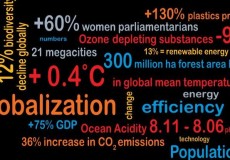- InformationHere you can find the documents for debate allowing us to advance on the reflections and issues of Rio+20. They can be concept papel, analysis, notes and reports.
Events December 2025 Mon Tue Wed Thu Fri Sat Sun 1 2 3 4 5 6 7 8 9 10 11 12 13 14 15 16 17 18 19 20 21 22 23 24 25 26 27 28 29 30 31 All events - Main Themes
- Ethical and philosophical fundamentals: subjectivity, domination, and emancipation
- Human rights, peoples, territories, and defense of Mother Earth
- Political subjects, the architecture of power, and democracy
- Production, distribution and consumption, access to wealth, common goods, and economies in transition
 November 04 2011
Keeping track of our changing environment
November 04 2011
Keeping track of our changing environment
By UNEP
Also available in Français, Español, Português
In 1992, the first United Nations Conference on Sustainable Development, popularly known as the Rio Earth Summit, was convened in Rio de Janeiro, Brazil to address the state of the environment and sustainable development. The Earth Summit yielded several important agreements including “Agenda 21”, a plan of action adopted by over 178 governments to address human impacts on the environment at local, national and global levels, and key treaties on climate change, desertification and biodiversity. At the second Conference in 2002—the World Summit on Sustainable Development—governments agreed on the Johannesburg Plan of Implementation, reaffirming their commitment to Agenda 21. In 2012, the United Nations Conference on Sustainable Development, or Rio+20 Earth Summit, will focus on the Green Economy in the context of sustainable development, poverty eradication, and the institutional framework for sustainable development. The object is to renew political commitment to sustainable development, review progress and identify implementation gaps, and address new and emerging challenges.
This publication serves as a timely update on what has occurred since the Earth Summit of 1992 and is part of the wider Global Environment Outlook-5 (GEO-5) preparations that will lead to the release of the landmark GEO-5 report in May 2012. It underlines how in just twenty years, the world has changed more than most of us could ever have imagined—geopolitically, economically, socially and environmentally. Very few individuals outside academic and research communities envisaged the rapid pace of change or foresaw developments such as the phenomenal growth in information and communication technologies, ever-accelerating globalisation, private sector investments across the world and the rapid economic rise of a number of “developing” countries. Many rapid changes have also taken place in our environment, from the accumulating evidence of climate change and its very visible impacts on our planet, to biodiversity loss and species extinctions, further degradation of land surfaces and the deteriorating quality of oceans. Certainly, there have been some improvements in the environmental realm, such as the significant reduction in ozone-depleting chemicals and the emergence of renewable energy sources, new investments into which totalled more than $200 thousand million in 2010. But in too many areas, the environmental dials continue to head into the red.
This innovative report is based entirely on statistical data and indicators and shows where the world stands on many social, economic and environmental issues as we enter the second decade of the 21st century.
Drivers of environmental change including population increase and economic growth, and especially the status of natural resources and landscapes, are clearly illustrated. Numbers plotted on straightforward graphs show upward and downward trends, which, along with satellite images, tell the story of dramatic changes.
Maintaining a healthy environment remains one of the greatest global challenges. Without concerted and rapid collective action to curb and decouple resource depletion and the generation of pollution from economic growth, human activities may destroy the very environment that supports economies and sustains life.
The upcoming Rio+20 Conference presents a timely, global-level opportunity to address one of its own stated objectives: to assess progress and gaps in implementing goals as part of an acceleration and scaling-up of transformative actions, programmes and policies. As we move towards the Rio+20 Conference in an ever-more globalised and integrated world, the need to chart progress towards a global Green Economy and more efficient and effective international environmental governance becomes vital. Without quantified targets, our environmental goals cannot turn theory into reality. Numeric and time-bound targets have certainly aided in progress made towards the Millennium Development Goals (MDGs), for example, and should be applied towards our environmental objectives as well.
This publication helps to tell the story of where the world was 20 years ago and where we collectively stand today, and to show the direction in which we need to move in a post-Rio+20 world. It also highlights the missing pieces in our knowledge about the state of environment— such as those related to freshwater quality and quantity, ground water depletion, ecosystem services, loss of natural habitat, land degradation, chemicals and waste—due to lack of regular monitoring, collection and compilation of data. Scientifically-credible data for environmental monitoring remains inadequate and the challenge of building in-country capacity to produce better policy-relevant data needs urgent attention.
We hope this report will inform all those participating in the Rio+20 events and the entire process and help set the world on a path towards a more sustainable environment.
Achim Steiner
United Nations Under-Secretary-General and Executive Director, UNEP
ActorsThe State and State officials
Joined documents